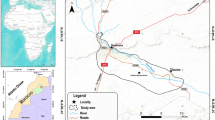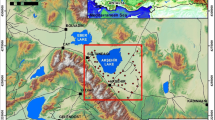Abstract
An intrinsic vulnerability map for a groundwater protection area for Datong City in China was developed using DRASTIC method which had been adapted to deal with the limited availability of data in the region. The compiled vulnerability map was then validated using two sets of Nemerow pollution indices which both integrated eight pollution parameters in the groundwater (pH, chloride, sulfate, nitrate, nitrite, total dissolved solid, total hardness and chemical oxygen demand) but were calculated by different approaches to provide integrated water quality assessments rather than specific pollution assessments like nitrate. The intrinsic groundwater vulnerability is divided into four classes due to the DRASTIC index values which lie in the range of (4, 8) in this study: “low”, “moderate”, “high” and “very high”. The validation process showed that the DRASTIC index values have a close correspondence with both sets of Nemerow pollution indices in the study area. The approaches used in this study for obtaining net recharge and vadose zone media data and values of hydraulic conductivity of aquifer sediments could be utilized elsewhere in China where there is a limited availability of data, as could the process of validating vulnerability maps using Nemerow pollution indices.






Similar content being viewed by others
Explore related subjects
Discover the latest articles and news from researchers in related subjects, suggested using machine learning.References
Administration of Quality Supervision, Inspection and Quarantine, Standardization Administration of China (1993) Groundwater quality standard (in Chinese). GB/T 14848-93
Aller L, Bennett T, Lehr JH, Petty RJ, Hackett G (1987) DRASTIC: a standardized system for evaluating ground water pollution potential using hydrogeologic settings. EPA/600/2-87-035, USEPA, Washington, DC
Cui Z, Wu T (2002) Shanxi geology. Shanxi Bureau of geology & mineral resources. In: Ma L (ed) Geological atlas of China (in Chinese). Geological Publishing House, Beijing
Datong Water Resources Management Committee, Datong Water Supplies Bureau, Office of the Datong Water Resources Management Committee (2014) Datong Water Resources Bulletin (in Chinese)
Huan H, Wang J, Teng Y (2012) Assessment and validation of groundwater vulnerability to nitrate based on a modified DRASTIC model: a case study in Jilin City of northeast China. Sci Total Environ 440:14–23. https://doi.org/10.1016/j.scitotenv.2012.08.037
Jamrah A, Al-Futaisi A, Rajmohan N, Al-Yaroubi S (2008) Assessment of groundwater vulnerability in the coastal region of Oman using DRASTIC index method in GIS environment. Environ Monit Assess 147:125–138. https://doi.org/10.1007/s10661-007-0104-6
Jinhui X, Datong Municipal Government Office (2018) Reply to the proposal of “Advices for strengthening the construction of our city’s backup water sources” (in Chinese). http://www.dt.gov.cn/dtzww/zxgb/201804/eb4e0fc2be4046069add34d619aaf48c.shtml. Accessed 12 Jan 2019
Kazakis N, Voudouris KS (2015) Groundwater vulnerability and pollution risk assessment of porous aquifers to nitrate: modifying the DRASTIC method using quantitative parameters. J Hydrol 525:13–25. https://doi.org/10.1016/j.jhydrol.2015.03.035
Kowalska JB, Mazurek R, Gasiorek M, Zaleski T (2018) Pollution indices as useful tools for the comprehensive evaluation of the degree of soil contamination—a review. Environ Geochem Health 40:2395–2420. https://doi.org/10.1007/s10653-018-0106-z
Mazurek R, Kowalska J, Gasiorek M, Zadrozny P, Jozefowska A, Zaleski T, Kepka W, Tymczuk M, Orlowska K (2017) Assessment of heavy metals contamination in surface layers of Roztocze National Park forest soils (SE Poland) by indices of pollution. Chemosphere 168:839–850. https://doi.org/10.1016/j.chemosphere.2016.10.126
Ministry of Geology and Mineral Resources of People’s Republic of China (1978) Manual of hydrogeology (in Chinese). Geological Publishing House, Beijing
Ministry of Water Resources of People’s Republic of China (2011) Notice on the publish of nationwide important drinking water source regions list (in Chinese). Water Resources Letter [2011] no. 109
Ministry of Water Resources of People’s Republic of China (2016) China Water Resources Bulletin (in Chinese). http://www.mwr.gov.cn/sj/tjgb/szygb/201707/t20170711_955305.html. Accessed 21 Oct 2017
Fischer G, Nachtergaele F, Prieler S, van Velthuizen H, Verelst L, Wiberg D (2008) Global agro-ecological zones assessment for agriculture (GAEZ 2008). IIASA, Laxenburg, Austria and FAO, Rome, Italy
NASA JPL (2013) NASA Shuttle Radar Topography Mission Global 1 arc second number, distributed by NASA EOSDIS Land Processes DAAC. https://doi.org/10.5067/measures/srtm/srtmgl1n.003
National Geological Data Center, National Digital Geological Data Archive (2013a) 1:200,000. Geological map J4929. http://219.142.81.86/igserver/ogc/kvp/TAS10R52000J49/WMTSServer. Accessed 21 Jan 2019
National Geological Data Center, National Digital Geological Data Archive (2013b) 1:200,000 Geological Map K4929. http://219.142.81.86/igserver/ogc/kvp/TAS10R52000K49/WMTSServer. Accessed 21 Jan 2019
National Research Council (1993) ground water vulnerability assessment: predicting relative contamination potential under conditions of uncertainty. National Academies Press, Washington DC. https://doi.org/10.17226/2050
Nemerow NL (1974) Scientific stream pollution analysis. Scripta Book Company, Washington DC
Rupert MG (2001) Calibration of the DRASTIC ground water vulnerability mapping method. Ground Water 39(4):625–630. https://doi.org/10.1111/j.1745-6584.2001.tb02350.x
Sener E, Davraz A (2013) Assessment of groundwater vulnerability based on a modified DRASTIC model, GIS and an analytic hierarchy process (AHP) method: the case of Egirdir Lake basin (Isparta, Turkey). Hydrogeol J 21(3):701–714. https://doi.org/10.1007/s10040-012-0947-y
Website of Datong People’s Government (2017) A brief introduction to Datong (in Chinese). http://www.dt.gov.cn/dtzww/dtgk/zjdt_nr.shtml. Accessed 12 Jan 2017
Wu H, Chen J, Qian H (2016) A modified DRASTIC model for assessing contamination risk of groundwater in the northern suburb of Yinchuan, China. Environ Earth Sci 75:483. https://doi.org/10.1007/s12665-015-5094-z
Xu G, Xie J, Zhang Y, Zhao C, Wu Q (2010) Application of Nemerow Pollution Index in Landscape River Water Quality Assessment of Tianjin. In: 4th International conference on bioinformatics and biomedical engineering. Chengdu, People’s Republic of China
Yang Z, Lu W, Long Y, Bao X, Yang Q (2011) Assessment of heavy metals contamination in urban topsoil from Changchun City, China. J Geochem Explor 108(1):27–38
Zhang Q, Feng M, Hao X (2018) Application of Nemerow index method and integrated water quality index method in water quality assessment of Zhangze Reservoir. https://doi.org/10.1088/1755-1315/128/1/012160
Zhou J, Li G, Liu F, Wang Y, Guo X (2010) DRAV model and its application in assessing groundwater vulnerability in arid area: a case study of pore phreatic water in Tarim Basin, Xinjiang, Northwest China. Environ Earth Sci 60:1055–1063. https://doi.org/10.1007/s12665-009-0250-y
Zhu M, Li Y, Li J, Yang L (2010) A Nemerow index and vague sets integrated water quality comprehensive assessment model. In: 4th International conference on bioinformatics and biomedical engineering, Chengdu, People’s Republic of China
Acknowledgements
Massive thanks to the reviewer for the generous changes and helpful comments on the manuscript.
Funding
This study was funded by National Key Research and Development Program of China (Grant numbers 2016YFC0402808, 2016YFA0601703), National Natural Science Foundation of China (Grant numbers 51479222).
Author information
Authors and Affiliations
Corresponding author
Ethics declarations
Conflict of interest
The authors declare that they have no conflict of interest.
Additional information
Publisher's Note
Springer Nature remains neutral with regard to jurisdictional claims in published maps and institutional affiliations.
Rights and permissions
About this article
Cite this article
Kong, M., Zhong, H., Wu, Y. et al. Developing and validating intrinsic groundwater vulnerability maps in regions with limited data: a case study from Datong City in China using DRASTIC and Nemerow pollution indices. Environ Earth Sci 78, 262 (2019). https://doi.org/10.1007/s12665-019-8255-7
Received:
Accepted:
Published:
DOI: https://doi.org/10.1007/s12665-019-8255-7




